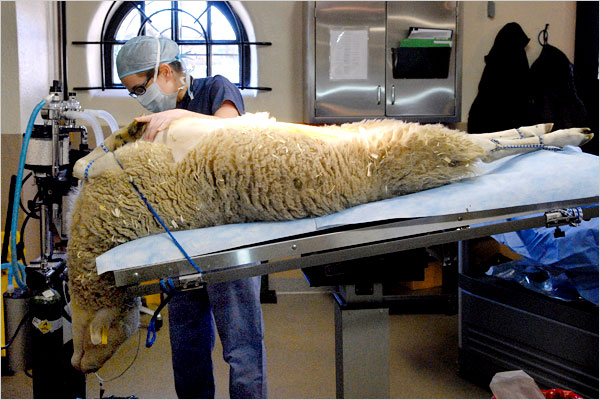
Is it quibbling to question the New York Times’ decision to run Rare Breeds, Frozen in Time in the Dining and Wine section, instead of the Science Times?
The story is about the SVF Foundation, a livestock preservation farm/lab that freezes and stores the sperm and embryos of heritage breeds. The writer, Barry Estabrook, does a good job in sketching out the potential catastrophe underlying current industrial livestock techniques, which (in)breeds so aggressively for value-adding uniform characteristics that it weakens the genetic makeup of popular lines. Holsteins, for example, “make up 93 percent of America’s dairy herd. Fewer than 20 champion bulls are responsible for half the genes,” according to the Holstein Association USA.
“Think of this as a safety valve program,” said Dr. George Saperstein, the [SVF] foundation’s chief scientific adviser, who is chairman of the Department of Environmental and Population Health at the Cummings School of Veterinary Medicine at Tufts University. “If there was a disaster, if something like the potato famine of livestock ever hit, these frozen embryos [of selected heritage breeds] would be made available, and in one generation we would be back in business.”
Peter Borden, SVF’s executive director, explains the obvious advantages heritage breeds present. They “have not been continuously ‘improved’ by humans…. They have been shaped by natural survival-of-the-fittest forces and can get along without human intervention.”
What a concept. An animal unimproved by man! This is in marked contrast to the modern “standardized” factory hog as portrayed in Nathaneal Johnson’s terrific 2006 Harper’s article Swine of the times: The making of the modern pig. (Such a good title. Couldn’t resist stealing it.)
The goal of modern factory livestock farming is the same for pork, beef, chicken, whatever. The business model, based as it is on efficiency and massive scale, finds it desirable to have “standardized” animals that grow at predictable rates and produce predictably uniform meat. The uniformity is necessary for, among other things, the slaughterhouse assembly line, one of the highest expressions of the deranged genius of industrial agriculture. Writes Johnson, “As swine carcasses move down the conveyor belt, at Hormel’s Austin, Minnesota, packing plant, they hit a curved knife, which slices the cylindrical loin from the inside of the body cavity. If the animals aren’t just the right proportions, the knife will hit the wrong spot, wasting meat or cutting into bone.”
That dystopian assembly line was the single image that stayed with me, and creeped me out, since I first read Johnson’s article. Of course there are no tradeoffs for this uniformity, right? Wellllllll….. Writes Johnson:
The modern pig is so susceptible to disease that producers must take extreme measures to transform their barns into pathogen-free bubbles. The pigs are vulnerable because they live in close quarters; and because they are genetically uniform, a bug that breaches the defenses of one pig’s immune system can hop to the next. A bacterium stowing away between a traveling boar’s toes could wipe out half a herd.
Johnson paints the most vivid and frightening picture of modern industrial agriculture I’ve come across. It would give PETA-sympathetic folks conniptions.
In just a little more than a decade, the modern hog industry has produced a tower of efficiency-maximizing products, one stacked atop the next, each innovation fixing the problem the last fix created. It is a monumental if somewhat haphazard structure, composed of slatted floors and aluminum crates, automatic sorting scales and mechanized wet-dry feeders. It is constructed of Genepacker sows, Tylan antibiotic feed, Agro-Clean liquid detergent, Argus salmonella vaccine, Goldenpig foam-tipped disposable AI catheters, CL Sow Re-placer milk substitute, and Matrix estrus synchronizer.
Brilliant system, right? What could go wrong?
Sorry, I digressed a bit as I revisited “Swine of the times.” (Really a must-read, and it’s not behind the famous Harper’s firewall, for all you cheapskates who don’t subscribe to the world’s best magazine). Back to the Times article. It’s well worth a look, and the companion slide show is good too. I just found it a little odd that the emphasis at the top of the article went on about “cutting-edge restaurants”* and “the next food trend” when much bigger issues, like the precariousness of the food supply, are really what’s at stake here.
___________
* and speaking of “cutting-edge restaurants”: when did it become conventional to prepend the chef/proprietor’s name to every mention? “David Schuttenberg’s Cabrito in the West Village, Rick Bayless’s Frontera Grill in Chicago and Tom Douglas’s Lola.” Annoying! I take off my hat to the restaurant PR flacks who made this a matter of journalistic policy at the Times.